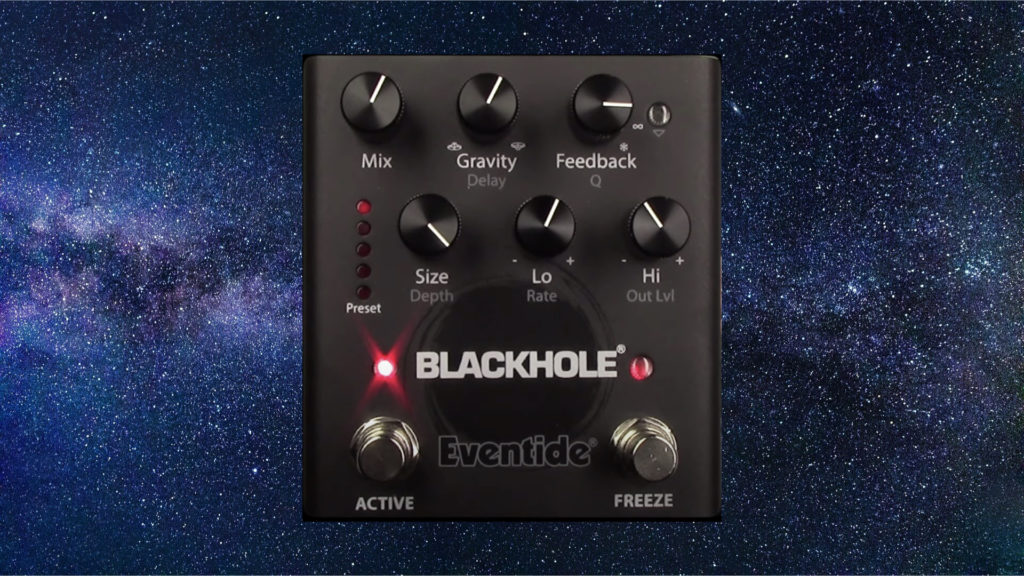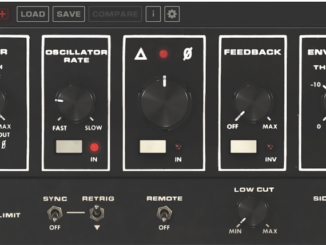Eventide has designed another product with its supermassive cosmic Blackhole reverb, this time in the form of a compact pedal.
One of the most popular reverbs on the market is definitely the super lush sounding Eventide Blackhole, which debuted in the DSP4000 Ultra-Harmonizer hardware processor for the first time. Since then, the algorithm has repeatedly been published in new products in new forms. As a VST/AU/AAX plugin for PC/Mac, as an iOS AUv3 app but also in hardware. In the H9 as an addon algorithm or in the beloved Space pedal.
The journey of the Blackhole Algorithm is not over, now the cosmic reverb is also available as a standalone reverb, but with an improved operation. Eventide describes the new Blackhole as “a big mysterious as the cosmos. Escape Earth and create haunting echoes, ethereal landscapes, and otherworldly ambiances.
Overview
The algorithm is not changed and is still a super lush reverb with which you can shoot sounds into space. However, the interface and the overall operation have been simplified significantly in the new Blackhole pedal. Instead of getting lost in deep menus, there are now two simple layers of parameters. The first layer features mix, gravity can for custom-tailor the reverb tail in two realms, normal or inverse decay, to create interesting swells or suck the dry signal back into the reverb tail. At longer decay times, Blackhole allows the articulation to shine through without competing with the reverb tail. Feedback introduces repeating, delay-like effects related to the pre-delay and gravity settings.
The size control allows you to change the size of the reverb from a cartoonishly small room to a limitless universe, while PreDelay can offset the onset of the reverb. Further, you can shape the tone with the lo, hi, and Q (resonance) parameters. However, the Q is situated on the second page where you can also find the delay function, the rate, and the output level. Blackhole’s tone controls can be used to add airiness or tame the low end. Movement can be added to the EQ controls via an expression pedal.
Not to forget, Blackhole also comes with the beloved infinite mode that continuously layers new sound on top of a suspended reverb while “Freeze mode” holds the effect in stasis, allowing musicians to play over the reverb tail. You get access to this unique dreamy feature via the freeze footswitch. Like in the other versions, the modulation is again built into the reverb structure. This allows smooth up to extreme modulations. A pity, the lovely ribbon controller from H9 series designed for sound morphing is missing here.
With Blackhole, users can pick and choose from five otherworldly presets to create supermassive atmospheres with the ethereal reverb of Blackhole, soar through nimbus clouds with the airy delay of Dark Matter, achieve sonic supernovas with the resounding swirl of Nebula, experience an uncharted galaxy of sound with the warmth of Singularity, and achieve a stellar rotation of sonority with Pulsar – or get creative and create presets on their own
Actually, you don’t need to do a first look or something for this pedal, you know it and we love the algorithm. If you are looking for a reverb pedal that transports your sounds into the deep space with supermassive atmospheres, you need this effect. If the pedal is too expensive for you, no problem, Blackhole is also available as an app or plug-in, which sound just as cool but without all the physical, hands-on control
Eventide Blackhole pedal is available now for $279 (MSRP) from Eventide dealers worldwide
More information here: Eventide





Be the first to comment